罗宾斯管理学管理理论与发展
斯蒂芬·P·罗宾斯《管理学》笔记2

斯蒂芬·P·罗宾斯《管理学》笔记第二章管理的昨天和今天一、管理与其他研究领域的联系1、人类学:有助于管理者更好地理解不同国家和不同组织中人们的基本价值观、态度和人们行为的差异。
2、经济学:提供了理解变化中的经济以及竞争和自由的全球市场环境的作用。
如:为什么运动鞋都是在亚洲国家制造?这可用经济学的竞争优质给出答案。
3、哲学:有助于考察事物的本质,特别是价值观和伦理道理,帮助管理者理解组织为什么存在以及什么行为对一个组织是适当的命题。
4、政治学:研究个人和群体在政治环境中的行为。
帮助管理者理解冲突的结构、在经济系统中权利的分配、个人如何为了自己的利益操纵权利、政府的影响。
5、心理学:帮助管理者理解人类的行为。
6、社会学:帮助管理者理解人与人之间的关系。
二、管理的历史背景20世纪前,管理方面的主要贡献1、埃及金字塔的建设、中国的长城,规模恢宏,管理者是如何进行计划、组织、领导和控制的?公元15世纪的威尼斯城的生产、运输、仓储、人事、会计模式表明组织管理已付诸实施。
2、1776年亚当·斯密关于劳动分工的著作《国富论》(the Wealth of Nations):将工作分解成狭窄的和重复性的任务,提高了工人技巧和熟练程度,导致工作专业化。
3、20世纪前的产业革命:以机械代替手工,大大提高劳动效率,对管理技能提出了更高的要求。
诸如管理者需要预测需求、分配人员工作、指挥每天的活动、协调各种任务、保证机器运行等。
计划、组织、领导和控制就成为必不可少的了,管理理论也应运而生。
4、管理进程:科学管理(1880s)--------行为科学(1920s)------管理科学(1950s)。
三、科学管理:从如何改进作业人员生产率的角度看管理。
1、主要学者:泰罗+吉尔布雷思夫妇2、泰罗的四条管理原则——关注管理的最低层次,追求完成每项具体工作的最佳方法,被称为“科学管理之父”。
①对工人的每一个要素开发出一种科学的方法,代替老的经验方法。
罗宾斯管理学
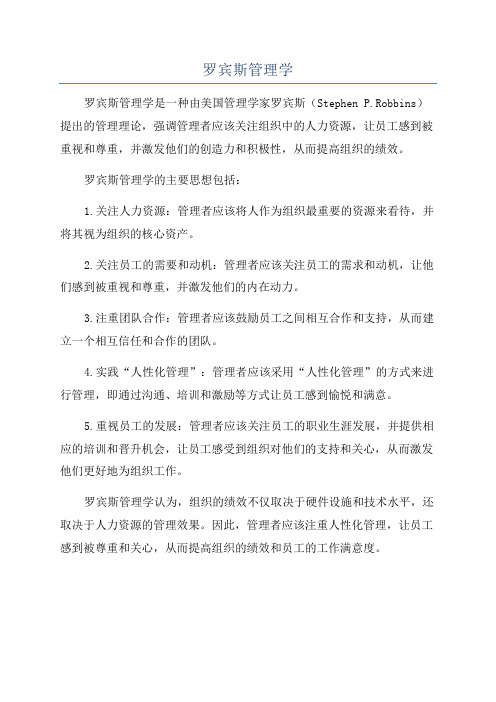
罗宾斯管理学
罗宾斯管理学是一种由美国管理学家罗宾斯(Stephen P.Robbins)提出的管理理论,强调管理者应该关注组织中的人力资源,让员工感到被重视和尊重,并激发他们的创造力和积极性,从而提高组织的绩效。
罗宾斯管理学的主要思想包括:
1.关注人力资源:管理者应该将人作为组织最重要的资源来看待,并将其视为组织的核心资产。
2.关注员工的需要和动机:管理者应该关注员工的需求和动机,让他们感到被重视和尊重,并激发他们的内在动力。
3.注重团队合作:管理者应该鼓励员工之间相互合作和支持,从而建立一个相互信任和合作的团队。
4.实践“人性化管理”:管理者应该采用“人性化管理”的方式来进行管理,即通过沟通、培训和激励等方式让员工感到愉悦和满意。
5.重视员工的发展:管理者应该关注员工的职业生涯发展,并提供相应的培训和晋升机会,让员工感受到组织对他们的支持和关心,从而激发他们更好地为组织工作。
罗宾斯管理学认为,组织的绩效不仅取决于硬件设施和技术水平,还取决于人力资源的管理效果。
因此,管理者应该注重人性化管理,让员工感到被尊重和关心,从而提高组织的绩效和员工的工作满意度。
管理学基础第二章、管理理论的形成与发展
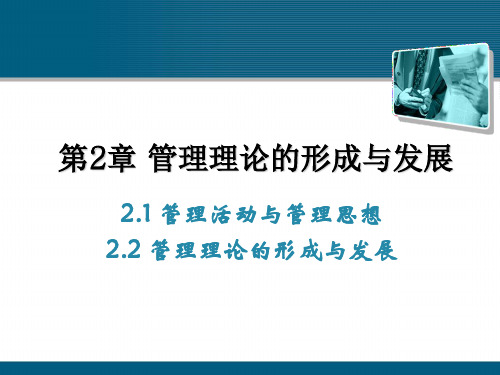
管理者是职业化的专家, 而不是所有管理单位的 所有者 职业生涯导向
工作分解为简单的、程序 化的和清晰定义的任务 劳动分工 权威等级 官僚行政组 织应该具有
第2章 管理理论的形成与发展
2.1 管理活动与管理思想 2.2 管理理论的形成与发展
每 日 一 则
最早的管理……
倦,于是停下来倾听其岳父叶忒罗的忠告:
——小寓言大道理
摩西在率领老百姓逃出埃及前往迦南的路上,对处理老百姓的怨言感到了厌 摩西的岳父说,你这做不好。你和这些百姓必都疲惫,因为这事太重,你独
• 法约尔总结出十四条管理原则(principles of manag
ement),见表2-2。所以,法约尔被公认为第一位概括 和阐述一般管理理论的管理学家。
表2-2 法约尔的十四条管理原则
1)劳动分工
2)职权 3)纪律
专业化通过使雇员的工作更有效率,从而提高了工作的产出
管理者必须有命令下级的权力,职权赋予管理者的就是这种权力。但是,凡行使职 权的地方,都应该建立责任 雇员必须遵守和尊重统治组织的规则
埃尔顿· 梅奥 20世纪30年代 员工是社会人 企业中存在非正 式组织 提高效率的主要 途径是提高工人的 满足程度
麦克兰 成就需要理论
弗鲁姆 期望理论
图2.4 行为管理理论的发展演变
霍桑试验与人际关系运动 • 梅奥及其领导的霍桑试验 • 该试验分四个阶段 第一阶段:工作场所照明试验(1924—1927年)
为什么说管理思想的革命性发展是在工厂制度产生 以后?
(完整版)罗宾斯《管理学》内容概要,中英文对照
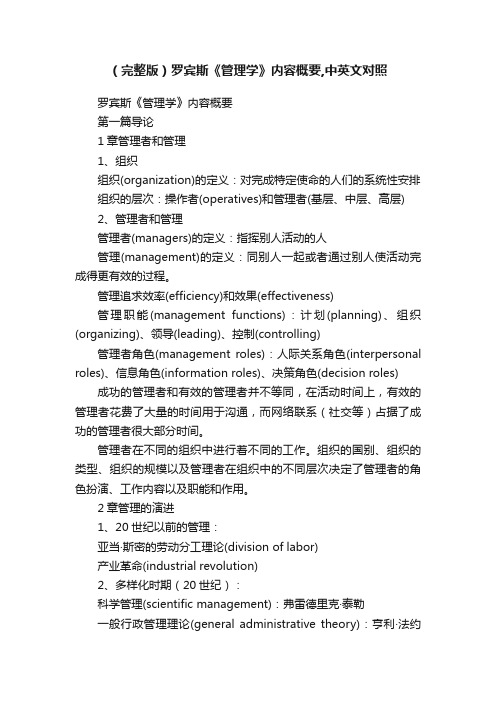
(完整版)罗宾斯《管理学》内容概要,中英文对照罗宾斯《管理学》内容概要第一篇导论1章管理者和管理1、组织组织(organization)的定义:对完成特定使命的人们的系统性安排组织的层次:操作者(operatives)和管理者(基层、中层、高层)2、管理者和管理管理者(managers)的定义:指挥别人活动的人管理(management)的定义:同别人一起或者通过别人使活动完成得更有效的过程。
管理追求效率(efficiency)和效果(effectiveness)管理职能(management functions):计划(planning)、组织(organizing)、领导(leading)、控制(controlling)管理者角色(management roles):人际关系角色(interpersonal roles)、信息角色(information roles)、决策角色(decision roles) 成功的管理者和有效的管理者并不等同,在活动时间上,有效的管理者花费了大量的时间用于沟通,而网络联系(社交等)占据了成功的管理者很大部分时间。
管理者在不同的组织中进行着不同的工作。
组织的国别、组织的类型、组织的规模以及管理者在组织中的不同层次决定了管理者的角色扮演、工作内容以及职能和作用。
2章管理的演进1、20世纪以前的管理:亚当·斯密的劳动分工理论(division of labor)产业革命(industrial revolution)2、多样化时期(20世纪):科学管理(scientific management):弗雷德里克·泰勒一般行政管理理论(general administrative theory):亨利·法约尔(principles of management)、马克斯·韦伯(bureaucracy) 人力资源方法(human resources approach):权威的接受观点(acceptance view of authority),霍桑研究,人际关系运动(卡内基、马斯洛),行为科学理论家(behavioral science theorists) 定量方法(quantitative approach)3、近年来的趋势(20世纪后期):趋向一体化过程方法(process approach)系统方法(systems approach):封闭系统和开放系统(closed systems)权变方法(contingency approach):一般性的权变变量包括组织规模、任务技术的例常性、环境的不确定性、个人差异4、当前的趋势和问题(21世纪):变化中的管理实践全球化(globalization)工作人员多样化(work force diversity)道德(morality)激励创新(innovations)和变革(changes)全面质量管理(total quality management, TQM):由顾客需要和期望驱动的管理哲学授权(delegation)工作人员的两极化(bi-modal work force)3章组织文化与环境:管理的约束力量1、组织组织文化(organizational culture)被用来指共有的价值体系。
罗宾斯管理学人大第九版课后思考题答案

7.能。比如研发性质的工作,或创造性质的工作,如:开发新产品,研究未知领域,艺术的创作,新奇的构想等。由于这些工作须要更大的自由性和充足的时间,不能用管理的方法硬性规定任务,否则会影响雇员的工作积极性,而且也不利于工作的效果。
8.同意,因为对于管理者而言,管理的方法与方式都是在不断的变化与发展的,在管理学中没有万能的、绝对的好方法,一切都是在不断更新的。面对不同的情况应有不同的对策,而如何去更好更快地完成工作,管理的研究就会有很多种答案,每种答案思考方式不一样,但最终结果都是为了更好更快地完成工作的。所以就会有各式各样的理论、流派,百花齐放,形成一股特定的艺术特色,就像不同风格的音乐,不同派别的油画,但都有自己特定的目标。所以管理是一门完成工作的艺术。
2定量方法能否帮助管理者解决人的问题,例如怎样激励员工以及如何合理地分配工作?请解释。
答:数量方法对于帮助管理者解决人的问题方面起着很重要的作用。
数量方法是在第二次世界大战期间用于解决军事问题的数学和统计方法的基础上发展起来的。所谓数量管理方法,是把运筹学、统计学和电子计算机用于管理决策和提高组织效率的一种思想。常用的数量方法有:线性规划、关键路线进度分析技术、经济订货数量模型等。
(2)玛丽?福莱特的行为科学研究创立了注重沟通好人际关系的人员导向型工作场所。她即把泰罗的细想加以概括,又提出了人际关系学说的一些观点,是科学管理和行为科学联系的桥梁。她的管理哲学思想这要是:【1】通过利益的结合减少冲突。对付冲突,不能采取压服或妥协的方法,必须看到共利益,通过双方利益的结合,使冲突双方都能得到充分的满足。【2】变服从个人权力为遵循形势规律。应该使命令“非人格化”,权威应该产生于职能,并与知识、经验相联系。【3】通过协作和控制达到目的。【4】领导应以他和拥护者的相互影响为基础。领导所依靠的不是命令和服从,而是协调和确定目标的技巧,唤起下属对形势规律的响应。福莱特是最早认识到应该用个人和群体行为为观点来看待组织的学者之一,比科学管理的追随者更进一步提出了人员导向的思想,认为组织应该遵循集体道德原则。
艺管考研罗宾斯《管理学》管理史重点笔记
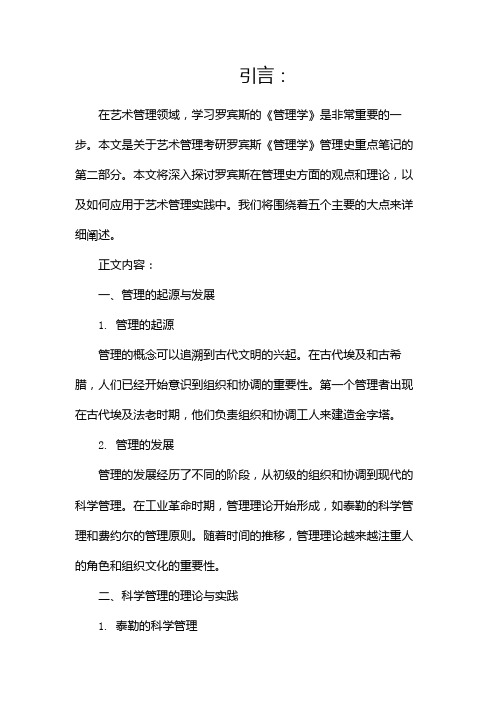
引言:在艺术管理领域,学习罗宾斯的《管理学》是非常重要的一步。
本文是关于艺术管理考研罗宾斯《管理学》管理史重点笔记的第二部分。
本文将深入探讨罗宾斯在管理史方面的观点和理论,以及如何应用于艺术管理实践中。
我们将围绕着五个主要的大点来详细阐述。
正文内容:一、管理的起源与发展1. 管理的起源管理的概念可以追溯到古代文明的兴起。
在古代埃及和古希腊,人们已经开始意识到组织和协调的重要性。
第一个管理者出现在古代埃及法老时期,他们负责组织和协调工人来建造金字塔。
2. 管理的发展管理的发展经历了不同的阶段,从初级的组织和协调到现代的科学管理。
在工业革命时期,管理理论开始形成,如泰勒的科学管理和费约尔的管理原则。
随着时间的推移,管理理论越来越注重人的角色和组织文化的重要性。
二、科学管理的理论与实践1. 泰勒的科学管理泰勒是科学管理的奠基人之一。
他提出了一种科学方法来提高工作效率,并鼓励管理者与员工密切合作,为员工提供培训和支持。
2. 赞同派管理理论赞同派管理理论强调管理者与员工之间的合作和沟通。
他们认为员工的参与和投入是关键要素,可以提高组织的绩效和员工的满意度。
3. 行政管理理论行政管理理论强调组织的层级结构和职权分配。
它关注组织内部的管理过程和流程,以确保有效的决策和资源分配。
三、人际关系学派的影响1. 埃尔顿·梅约的研究埃尔顿·梅约通过对西部电气公司的研究,证明了工作满意度与生产力之间的关系。
他发现,工作满意度可以通过有效管理人际关系来提高。
2. 霍桑研究霍桑研究是对人际关系学派的重要研究之一。
研究发现,员工的生产力与他们被关注和关心程度有关,这引起了对员工的关怀、激励和参与的关注。
四、组织文化的重要性1. 组织文化的定义组织文化是指组织内部共享的价值观、信念和行为模式。
它可以影响员工的行为和组织的绩效。
2. 组织文化对艺术管理的影响在艺术管理领域,艺术机构的组织文化对其发展和运营至关重要。
斯蒂芬P罗宾斯管理学归纳

斯蒂芬P罗宾斯管理学归纳组织的特性:任何组织都有明确的目的;任何组织都是由人构成的;任何组织都发育出一种系统性结构。
组织也可表述为:具有明确目的、由人构成的与具有系统性结构的实体。
管理者与操作者管理者(Managers):是在组织中工作并指挥别人工作的人。
作为管理者一定有下属。
操作者(Operatives):是在组织中直接从事某项工作或者任务,不具有监督其他人工作的职责的人。
操作者没有下属。
什么是管理与管理者的工作1.什么是管理?管理(Management):是管理者为实现组织目标同别人一起,或者通过别人使组织活动完成得更加有效的过程。
在这一过程中管理者发挥计划、组织、领导、操纵等职能。
管理的有效性:管理效率与管理效果的统一性a)效率(Efficiency):指输入与输出的关系。
在既定输入条件下,输出越大,效率越高。
在管理中输入的是具有稀缺性的资源,提高效率意味着对稀缺性资源的有效利用。
b)效果(Effectiveness):指管理活动在实现组织目标过程中所达到的结果。
2.管理者的工作管理者的工作是指管理者在实现组织目标过程中具体做什么?存在两种基本理论:管理职能理论;管理者角色理论。
a)管理职能(Management functions)理论:从管理过程的角度表述管理者是做什么的。
许多管理学者对此有自己的看法。
b)管理者角色(Management roles)理论:60年代末期,亨利·明茨伯格提出。
从管理者在管理中充当的角色来表述管理者是做什么的。
斯蒂芬·P·罗宾斯的关于管理的四个基本职能计划组织领导协调5.管理者工作的特殊性不一致的管理层次、同的组织类型、同的组织规模、同国度的组织早期的管理实践与思想(——19世纪末)亚当•斯密(Adam Smith)在1776年发表的《国富论》著作中提出,劳动分工(Division of Labor)能提高劳动生产率,组织与社会将从劳动分工中获得巨大经济利益的光辉论断。
罗宾斯管理学知识点复习

CH1 总论1.简述管理学基础的基本内容.理解学习管理的重要作用。
管理的必要性:资源短缺科技落后,高度专业化,团队合作,网络经济,虚拟经济2.各个管理层次的划分及其职能是什么?⏹高层管理者:制定战略、组织资源完成组织目标.⏹中层管理者:接受组织目标将其分解为事业部目标,向下解释和传达高层意图,向上传递低层信息.⏹基层管理者:给下属作业人员分派具体工作;直接指挥和监督现场作业。
3.综合管理人员与专业管理人员的主要区别是什么?•综合管理人员-指负责整个组织或组织中某个事业部的全部活动的管理者。
•专业管理人员-指仅仅负责管理组织中某一类活动(或职能)的管理者。
如财务、营销、人力资源、质检、物流、开发等。
4.什么是管理?管理概念的四个层次和四大职能分别是什么?管理是指在特定环境下对组织所拥有的资源进行有效的计划、组织、领导和控制,以便实现既定的组织目标的过程。
管理定义的四层含义:1.管理是为实现组织目标服务,是有组织有目的进行的过程;2.由一系列相互关联、连续进行的工作活动构成,即计划、组织、领导、控制等;3.管理通过运用资源来实现,其有效性从效率和效果来判断;4.管理在一定的环境条件下开展,受其影响.四大层次:•目标-—管理必须服务于组织的目标.•过程—-管理是由一系列相互关联、连续进行的活动所构成的,包括组织、计划、领导、控制等。
•资源——有效利用各种资源达成组织的目标。
•环境-—管理离不开特定的内外环境四大职能:5.如何理解管理者扮演的十种角色?明茨伯格:可组成三方面:人际关系(挂名首脑、领导者、联络者)、信息传递(监听者、传播者、发言者)、决策制定(企业家、混乱驾御者、资源分配者、谈判者)6。
理解管理者技能的内涵及其各个管理层次对管理技能的要求.•技术技能——使用某一专业领域有关的工作程序、技术和知识完成组织任务的能力.管理人员需要了解并初步掌握它。
•人际技能—-理解、激励他人并与他人共事的能力.此能力对全部管理人员都重要.•概念技能—-综观全局、认清为什么要做某事,调查企业与环境相互影响的复杂性的能力。
管理学罗宾斯

管理学罗宾斯管理学是一门研究组织和企业管理的学科,它涵盖了企业战略、组织结构、领导力、人力资源管理、营销和运营管理等方面的内容。
在管理学中,罗宾斯是一个重要的学者,他的理论和观点对于现代管理实践具有重要的指导意义。
本文将重点介绍罗宾斯的管理学理论和他在管理实践中的应用。
罗宾斯管理学理论的核心观点之一是“参与式管理”。
他认为,企业和组织中的员工应该更多地参与到决策过程中,而不仅仅是被动地接受管理者的指令。
这种参与可以通过建立开放的沟通渠道和鼓励员工提出建议和意见来实现。
罗宾斯认为,参与式管理可以提高员工的工作满意度和投入感,并最终促进组织的绩效提升。
另一个重要的罗宾斯的管理学理论是“激励理论”。
罗宾斯认为,人的行为是受到动机驱使的,只有通过适当的激励措施,才能激发员工的积极性和创造力。
他提出了各种各样的激励理论,如Maslow的需求层次理论和赫茨伯格的双因素理论,并指导管理者如何根据员工的需要和动机进行激励。
此外,罗宾斯也对领导力的研究做出了重要贡献。
他提出了“事务型领导”和“变革型领导”两种领导风格。
事务型领导侧重于任务的执行和规范的实施,而变革型领导则强调启发员工的创新和发展潜力。
罗宾斯认为,不同的情境和组织需要不同的领导风格,管理者应根据实际情况选择合适的领导方式。
在管理实践中,罗宾斯的理论和观点也得到了广泛的应用。
首先,很多企业和组织在员工参与方面借鉴了罗宾斯的参与式管理理念。
他们建立了多种形式的员工参与机制,如员工代表制度、团队决策和员工参与项目等,以实现员工参与和协调。
其次,在激励方面,管理者也广泛运用罗宾斯的激励理论。
他们制定了各种激励政策和奖励机制,如薪酬制度、绩效评估和激励计划,以激发员工的动力和积极性。
这些措施不仅提高了员工的工作热情,还有效地促进了组织的绩效。
最后,在领导力方面,管理者也注重培养和发展变革型领导。
他们关注员工的发展需求,为他们提供培训和发展机会,激励他们挖掘和实现潜能。
斯蒂芬·P·罗宾斯《管理学》

(二)管理者角色(亨利·明茨伯格):
• • • • • • 1、管理者角色:特定的管理行为范畴 ①人际关系:挂名首脑、领导者、联络者 ②信息传递:监听者、传播者、发言人 ③决策制定:企业家、混乱驾御者、资源分配者、谈判者 2、管理者角色与传统管理职能理论的关系: ①职能方法仍然代表着将管理者的工作概念化的最有效方 法。 • ②管理者角色实质上与四种职能是一致的。 • 资源分配角色是计划职能的一部分,企业家角色和所有的 三个人际关系角色是领导职能的一部分 • 3、企业家角色:寻求组织和环境中的机会,制定“改进 方案”以发起变革
第2 章 管理的昨天和今天
• • • • 第1 节 管理的历史背景 20 世纪前,在管理方面的主要贡献 1、埃及金字塔的建设、罗马教会 2、亚当·斯米关于劳动分工的著作:将工作 分解成一些单一和重要性的作业,提高工 人技巧和熟练程度。 • 3、产业革命 :提高效率
第2 节 多样化的时期 (20 世纪前半 期)
第4 节 当前的趋势和问题:变化中 的管理实践
• ① 全球化 • ② 劳动力多元化 • ③ 创业精神:是一个过程,即某个人或者 某个群体通过有组织的努力,以创新和独 特的方式追求机会、 • 创造价值和谋求增长,不管这些人手中是 否拥有资源。
• ④ 电子企业领域中的管理 • 电子企业:描述了一个组织通过电子联结与 它的关键利益相关者开展工作的方式,以便更有 效 • 率地实现其目标 • 电子商务:是企业与其利益方通过电子方式 进行交换与交易的任何方式(B2B、C2C、B2C、 • G2B) • 电子企业介入的领域: • 电子增强型组织:在传统组织中建立电子企 业单元,同时维持传统结构 • 电子企业驱动型(使能型)组织:利用电子 企业工具完成传统功能 • 全部电子化的企业
管理学罗宾斯

管理学罗宾斯管理学是一门研究有关组织和管理的学科,它关注的是如何有效地规划、组织、指导和控制组织中的资源以实现组织的目标。
而罗宾斯是管理学领域的知名学者,他的研究贡献深远,对管理学的发展起到了重要的推动作用。
罗宾斯,全名史蒂芬·帕特里克·罗宾斯(Stephen P. Robbins),是一位美国著名的管理学家和作者。
他于1943年出生于加利福尼亚州,曾就读于加州州立大学和南加利福尼亚大学,并获得了心理学和统计学的学士学位,以及管理学的博士学位。
罗宾斯还拥有经济学和社会学方面的深厚知识背景,这使得他能够从多个角度研究管理学的问题。
罗宾斯的研究兴趣涵盖了组织行为、人力资源管理、领导力和决策等方面。
他的专著《组织行为学》、《管理》和《人力资源管理》是管理学领域的经典作品,被广大学生和管理从业者广泛引用。
他的研究对于组织内部的员工行为和管理效能有着深刻的洞察力,为管理者提供了很多实用的指导和建议。
在《组织行为学》这本书中,罗宾斯详细介绍了组织行为的基本概念和理论框架。
他对个体行为、团队行为和组织整体行为进行了系统的分析,从而帮助管理者更好地理解和应对不同的行为情况。
他提出了很多有关激励、沟通、决策和领导力等方面的观点,为组织内部的运作和管理提供了很多实用的建议。
另外,罗宾斯还将心理学的一些理论和方法应用于管理学的研究中。
他对个体的动机、满足和工作态度进行了深入研究,并提出了激励理论、满足理论和工作特征模型等。
这些理论和模型有效地解释了员工在工作中的行为和动机,帮助管理者了解员工需求,提高员工满意度和工作绩效。
此外,罗宾斯还关注了组织的整体运作和管理。
他提出了系统理论和系统思维的概念,强调了组织内各个部门和个体之间的相互影响和依赖关系。
他认为,组织应该从系统的角度来思考问题,并采取综合的方法来管理各个方面的运作。
总之,罗宾斯的研究和著作在管理学领域产生了广泛的影响。
他深入探讨了组织行为、个体动机以及组织整体的管理,为管理实践提供了很多有益的思路和方法。
罗宾斯管理学
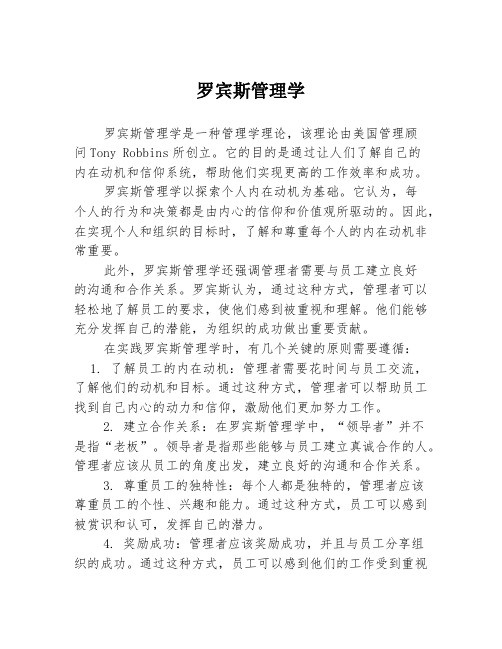
罗宾斯管理学罗宾斯管理学是一种管理学理论,该理论由美国管理顾问Tony Robbins所创立。
它的目的是通过让人们了解自己的内在动机和信仰系统,帮助他们实现更高的工作效率和成功。
罗宾斯管理学以探索个人内在动机为基础。
它认为,每个人的行为和决策都是由内心的信仰和价值观所驱动的。
因此,在实现个人和组织的目标时,了解和尊重每个人的内在动机非常重要。
此外,罗宾斯管理学还强调管理者需要与员工建立良好的沟通和合作关系。
罗宾斯认为,通过这种方式,管理者可以轻松地了解员工的要求,使他们感到被重视和理解。
他们能够充分发挥自己的潜能,为组织的成功做出重要贡献。
在实践罗宾斯管理学时,有几个关键的原则需要遵循:1. 了解员工的内在动机:管理者需要花时间与员工交流,了解他们的动机和目标。
通过这种方式,管理者可以帮助员工找到自己内心的动力和信仰,激励他们更加努力工作。
2. 建立合作关系:在罗宾斯管理学中,“领导者”并不是指“老板”。
领导者是指那些能够与员工建立真诚合作的人。
管理者应该从员工的角度出发,建立良好的沟通和合作关系。
3. 尊重员工的独特性:每个人都是独特的,管理者应该尊重员工的个性、兴趣和能力。
通过这种方式,员工可以感到被赏识和认可,发挥自己的潜力。
4. 奖励成功:管理者应该奖励成功,并且与员工分享组织的成功。
通过这种方式,员工可以感到他们的工作受到重视和尊重。
罗宾斯管理学与其他管理学理论相比,最大的不同之处在于它的关注重点是个人内在的动力和信仰系统。
通过理解个人的动力和信仰系统,管理者可以激发员工的激情和热情,帮助他们实现更高的工作效率和成功。
总之,罗宾斯管理学是一种非常有用的管理学理论。
它的核心在于了解员工的内在动机和信仰系统,建立良好的沟通和合作关系,并且尊重员工的独特性。
通过实践这些原则,管理者可以帮助员工实现更高的工作效率和成功。
罗宾斯《管理学》
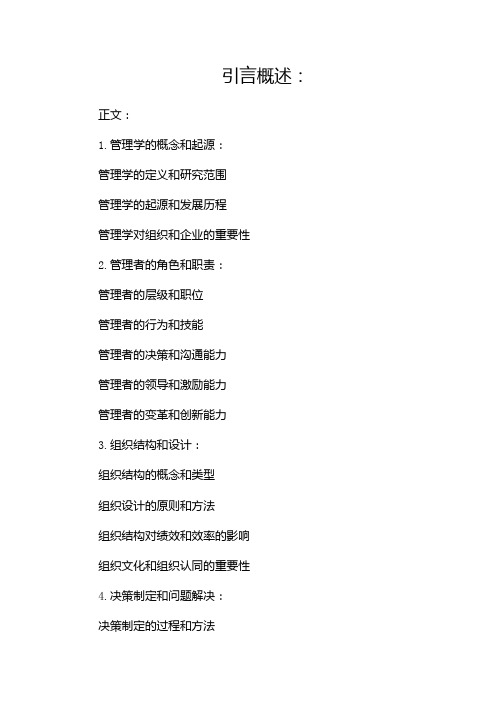
引言概述:正文:
1.管理学的概念和起源:
管理学的定义和研究范围
管理学的起源和发展历程
管理学对组织和企业的重要性
2.管理者的角色和职责:
管理者的层级和职位
管理者的行为和技能
管理者的决策和沟通能力
管理者的领导和激励能力
管理者的变革和创新能力
3.组织结构和设计:
组织结构的概念和类型
组织设计的原则和方法
组织结构对绩效和效率的影响
组织文化和组织认同的重要性
4.决策制定和问题解决:
决策制定的过程和方法
决策制定的模型和工具
问题解决的步骤和技巧
决策制定和问题解决的挑战和障碍
决策制定和问题解决的案例研究
5.领导和企业文化:
领导的概念和类型
领导的特质和行为
领导与管理的区别和联系
企业文化的重要性和影响力
企业文化的塑造和改变
总结:
罗宾斯的《管理学》全面而深入地探讨了管理学的理论和实践。
通过详细的分析和案例研究,本书为读者提供了有关管理学的重要概念、原则和方法。
在管理学的各个领域,本书都提供了详细的讨论和启示,使读者能够更好地理解和应用管理学的知识。
本书也有一些不足之处,例如对一些新兴概念和技术的应用尚未涉及,以及缺乏一些最新的案例研究。
尽管如此,罗宾斯的《管理学》仍然是一本经典的管理学著作,值得读者深入研究和学习。
罗宾斯《管理学》课后习题答案

罗宾斯《管理学》课后习题答案第Ⅰ篇绪论第一章管理与组织导论一、谁是管理者1.管理者在哪些方面不同于非管理人员?答:协调其他人的工作——区分了管理岗位与非管理岗位。
2.说明为什么并不总能很容易地确定谁是组织中的管理员。
答:组织以及工作正在变化的性质模糊了管理者与非管理雇员之间的界限,许多传统的职位现在都包括了管理性的活动,特别是在团队中(团队成员通常要制定计划、决策以及监督自己的绩效),非管理雇员也承担着过去是管理者的一部分职责。
补充:⑴管理者:管理者是这样的人,他通过协调其他人的活动达到与别人一起或者通过别人实现组织的目标。
3.对比三种不同的管理层次。
答:①基层管理者是最低层的管理人员,他们管理着非管理雇员所从事的工作,这些工作生产和提供组织的产品。
②中层管理者包括所有处于基层和高层之间的各个管理层次的管理者,这些管理者管理着基层管理者。
③高层管理者处于或接近组织顶层,他们承担着制定广泛的组织决策、为整个组织制定计划和目标的责任。
注:并不是所有的组织都具有金字塔形的组织结构,但都需要某个人来扮演管理者的角色,即需要有人来协调工作和活动,以便能够同别人一起或者通过别人来实现组织的目标。
二、什么是管理补充:⑴管理:定义为一个协调工作活动的过程,以便能够有效率和有效果地同别人一起或通过别人实现组织的目标。
要点:①过程代表了一系列进行中的有管理者参与的职能或活动,这些职能一般划分为计划、组织、领导和控制。
②协调其他人的工作——区分了管理岗位与非管理岗位。
③有效率和有效果地完成组织的工作活动。
4.如何理解管理是一个过程。
答:上面要点①。
5.定义效率和效果。
答:①效率是指以尽可能少的投入获得尽可能多的产出。
通常指的是“正确地做事”,即不浪费资源。
②效果通常是指“做正确的事”,即所从事的工作和活动有助于组织达到其目标。
③可见,效率是关于做事的方式;效果是指实现组织目标的程度,涉及事情的结果。
6.解释效率和效果对管理的重要性。
管理学罗宾斯

计划工作的 目的和意义
1、明确方向,指导组织成员的工作 2、减少环境变化的冲击,降低风险 3、减少浪费和重复,提高效率 4、设立控制的标准,保障目标的实 现
计 划 工 作 的 步 骤
识别机会 根据:市场 竞争 需求 优势 劣势 确立目标 要在什么方向、需要实 现什么目标和何时完成 拟定前提条件 我们的计划将在什么样 的内部环境和外部环境 中执行 确定可供选择的方案 为完成目标开发可供选 择的行动方针
管理学
罗宾斯
感谢赵旭老师的分享
管理导论及基础知识
01 管理 02 管理者 03 管理环境 04 管理学 05 管理理论发展 06 管理学派
组织(organization):组织是一切管理活动的载体,是由人们组成的、具有明
确目的和系统性结构的实体。无论是国家、军队、教会等庞然大物,还是企业、学校、 医院等小型单位,它们都是组织,因为它们都具有三种共同的特征,如下图所示。
职能
1 2
计划
领导
3 4
组织
控制
1
计划
01 计划与决策 02 战略管理
计划与决策
计划的基础 目标管理
决策与决策制定
计划的方法与技术
计划的概念
计划包括确定组织目标、制定全局战略以实现这些目标,制定全面的分层计划体系以综合 和协调各种活动。因此,计划既涉及目标,也涉及达到目标的方法。 具体而言,计划是指包括定义组织的目标、制定全局战略以及开发一组广泛的相关计划以 整合和协调组织的工作。从计划的定义可知,计划工作需要有意识地决定组织的发展方向, 它既需要确定组织当前的目标,也需要考虑组织的未来;既需要考虑组织长期的使命和发 展战略,也需要考虑具体的业务开展计划;既关系到结果,也关系到手段。
管理学罗宾斯
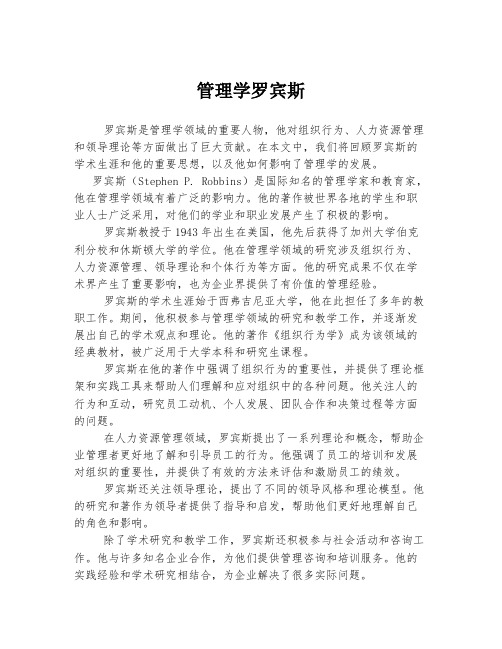
管理学罗宾斯罗宾斯是管理学领域的重要人物,他对组织行为、人力资源管理和领导理论等方面做出了巨大贡献。
在本文中,我们将回顾罗宾斯的学术生涯和他的重要思想,以及他如何影响了管理学的发展。
罗宾斯(Stephen P. Robbins)是国际知名的管理学家和教育家,他在管理学领域有着广泛的影响力。
他的著作被世界各地的学生和职业人士广泛采用,对他们的学业和职业发展产生了积极的影响。
罗宾斯教授于1943年出生在美国,他先后获得了加州大学伯克利分校和休斯顿大学的学位。
他在管理学领域的研究涉及组织行为、人力资源管理、领导理论和个体行为等方面。
他的研究成果不仅在学术界产生了重要影响,也为企业界提供了有价值的管理经验。
罗宾斯的学术生涯始于西弗吉尼亚大学,他在此担任了多年的教职工作。
期间,他积极参与管理学领域的研究和教学工作,并逐渐发展出自己的学术观点和理论。
他的著作《组织行为学》成为该领域的经典教材,被广泛用于大学本科和研究生课程。
罗宾斯在他的著作中强调了组织行为的重要性,并提供了理论框架和实践工具来帮助人们理解和应对组织中的各种问题。
他关注人的行为和互动,研究员工动机、个人发展、团队合作和决策过程等方面的问题。
在人力资源管理领域,罗宾斯提出了一系列理论和概念,帮助企业管理者更好地了解和引导员工的行为。
他强调了员工的培训和发展对组织的重要性,并提供了有效的方法来评估和激励员工的绩效。
罗宾斯还关注领导理论,提出了不同的领导风格和理论模型。
他的研究和著作为领导者提供了指导和启发,帮助他们更好地理解自己的角色和影响。
除了学术研究和教学工作,罗宾斯还积极参与社会活动和咨询工作。
他与许多知名企业合作,为他们提供管理咨询和培训服务。
他的实践经验和学术研究相结合,为企业解决了很多实际问题。
罗宾斯通过他的著作和教学工作,对无数学生和职业人士的生活产生了积极的影响。
他的观点和理论帮助人们更好地理解组织和管理,指导他们在工作和生活中做出明智的决策。
斯蒂芬·P·罗宾斯-管理学(第10版)

斯蒂芬·P·罗宾斯-管理学(第10版)1. 介绍《斯蒂芬·P·罗宾斯-管理学(第10版)》是管理学领域的经典教材之一。
本书由著名管理学家斯蒂芬·P·罗宾斯(Stephen P. Robbins)撰写,从理论和实践两方面全面介绍了管理学的基本原理和方法。
本书在全球范围内广受欢迎,并被广泛应用于大学本科和研究生的管理学教育中。
2. 内容概述《斯蒂芬·P·罗宾斯-管理学(第10版)》共分为12个章节,内容涵盖了管理学的主要领域和理论。
以下是各章节的简要介绍:第1章:管理与组织本章介绍了管理学的基本概念和定义,并探讨了组织的概念和作用。
还介绍了管理学研究的历史和发展。
第2章:管理环境本章主要讲述管理学与环境的关系,包括宏观环境和微观环境对管理决策的影响。
介绍了政治、法律、经济、技术等因素对组织和管理的影响。
第3章:管理者的角色本章主要介绍了管理者的角色和职责,包括计划、组织、领导和控制等方面的内容。
还讨论了管理者的能力要求和领导风格选择的问题。
第4章:决策与管理本章着重讲述决策的过程和方法,包括问题诊断、信息收集、方案评估和选择等步骤。
介绍了常见的决策问题和解决方法。
第5章:组织结构与设计本章探讨了组织结构的概念和原理,介绍了各种常见的组织结构形式,并讨论了组织设计的原则和方法。
第6章:管理控制与系统本章讲述了管理过程中的控制和反馈机制,介绍了管理控制的概念和方法。
还介绍了系统理论在管理控制中的应用。
第7章:领导与管理本章主要介绍了领导与管理之间的关系,讨论了领导能力和领导风格的重要性。
还探讨了如何培养和发展领导能力。
第8章:团队与团队建设本章讨论了团队的概念和特点,介绍了团队建设的原则和方法。
还介绍了团队合作和团队动力的重要性。
第9章:人力资源管理本章主要讲解了人力资源管理的基本原理和方法,包括招聘、培训、绩效管理、激励和薪酬等方面的内容。
管理学重点罗宾斯第七版

1、管理指的是协调和监管他人的工作活动,从而使他们有效率、有效果地完成工作。
2、管理的核心:效率和效果3、效果有两层含义:一是目标的适宜度,即管理者所选择组织目标的适宜程度,二是目标的达成度,即组织实现目标程度。
它的本质是“做正确的事”。
4、效率与效果的关系:在成功的组织中,高效率和高效果往往是相辅相成的,而糟糕的管理(会导致糟糕的绩效)通常既是低效率的也是低效果的,或者虽然有效果但是却是低效率的。
达到人际关系角色:涉及人与人(下属以及组织外的人)的关系以及其他礼仪性和象征性的职责。
【挂名首脑、领导者、联络者】信息传递角色:涉及收集、接受和传播信息。
【监听者、传播者、发言人】决策制定角色:需要作出决策或选择、【企业家、混乱驾驭者、资源分配者、谈判者】6、管理技能。
技术技能:执行一项特定工作的能力。
人际技能:有效沟通和激励他人的能力。
概念技能:思考问题、分析问题的能力。
7、管理者面对的变化(掌握)变化变化的影响不断变化的技术(数字化)组织边界的改变虚拟的工作场所流动性更高的劳动力队伍灵活的工作安排向员工授权工作与生活的平衡对组织和管理伦理的更多的强调重新定义的价值观重新建立的信任更大的责任更激烈的竞争顾客服务创行全球化效率/生产率不断变化的安全威胁风险管理未来的能源资源/价格的不确定性重构工作场所歧视全球化员工帮助计划经济气候的不确定性8、组织是对人员的一种精心安排,以实现某个特定目的。
9、组织的特征:①每个组织都有一个明确的目标。
②每个组织都由人员组成。
③所有的组织都发展出一种精细的结构,以使人员能够在其中从事他们的工作。
1011亚当斯密发表《国富论》。
他在该书中指出,组织和社会将从劳动分工(或工作专业化)中获得经济优势。
所谓劳动分工,就是将工作分解为狭窄的、重复性的任务。
工业革命始于18世纪晚期,当时机器动力代替了人力,使得在工厂中制造产品比在家庭内生产更具有经济性。
使用科学的方法来确定一种完成工作的"最佳方法"。
(完整)罗宾斯管理学
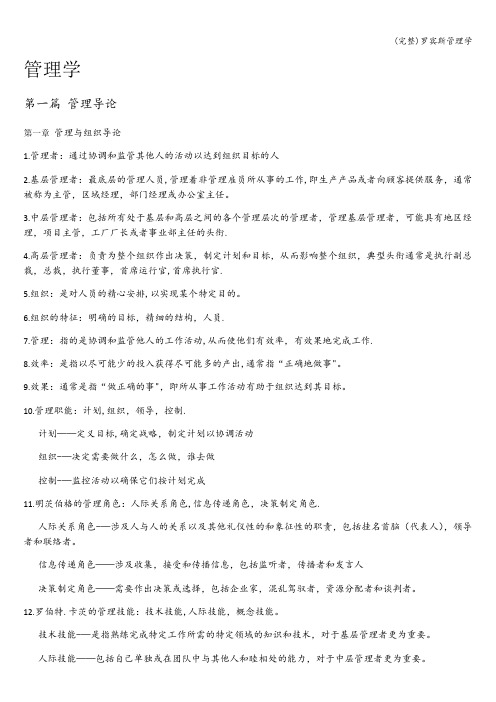
管理学第一篇管理导论第一章管理与组织导论1.管理者:通过协调和监管其他人的活动以达到组织目标的人2.基层管理者:最底层的管理人员,管理着非管理雇员所从事的工作,即生产产品或者向顾客提供服务,通常被称为主管,区域经理,部门经理或办公室主任。
3.中层管理者:包括所有处于基层和高层之间的各个管理层次的管理者,管理基层管理者,可能具有地区经理,项目主管,工厂厂长或者事业部主任的头衔.4.高层管理者:负责为整个组织作出决策,制定计划和目标,从而影响整个组织,典型头衔通常是执行副总裁,总裁,执行董事,首席运行官,首席执行官.5.组织:是对人员的精心安排,以实现某个特定目的。
6.组织的特征:明确的目标,精细的结构,人员.7.管理:指的是协调和监管他人的工作活动,从而使他们有效率,有效果地完成工作.8.效率:是指以尽可能少的投入获得尽可能多的产出,通常指“正确地做事"。
9.效果:通常是指“做正确的事",即所从事工作活动有助于组织达到其目标。
10.管理职能:计划,组织,领导,控制.计划——定义目标,确定战略,制定计划以协调活动组织-—决定需要做什么,怎么做,谁去做控制-—监控活动以确保它们按计划完成11.明茨伯格的管理角色:人际关系角色,信息传递角色,决策制定角色.人际关系角色-—涉及人与人的关系以及其他礼仪性的和象征性的职责,包括挂名首脑(代表人),领导者和联络者。
信息传递角色——涉及收集,接受和传播信息,包括监听者,传播者和发言人决策制定角色——需要作出决策或选择,包括企业家,混乱驾驭者,资源分配者和谈判者。
12.罗伯特.卡茨的管理技能:技术技能,人际技能,概念技能。
技术技能-—是指熟练完成特定工作所需的特定领域的知识和技术,对于基层管理者更为重要。
人际技能——包括自己单独或在团队中与其他人和睦相处的能力,对于中层管理者更为重要。
概念技能——是管理者用来对抽象,复杂的情况进行思考和概念化的技能,对于高层管理者更为重要。
罗宾斯管理学
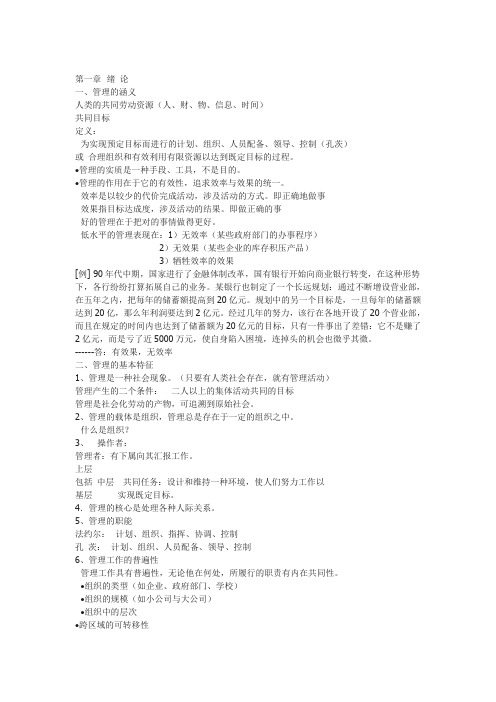
第一章绪论一、管理的涵义人类的共同劳动资源(人、财、物、信息、时间)共同目标定义:为实现预定目标而进行的计划、组织、人员配备、领导、控制(孔茨)或合理组织和有效利用有限资源以达到既定目标的过程。
•管理的实质是一种手段、工具,不是目的。
•管理的作用在于它的有效性,追求效率与效果的统一。
效率是以较少的代价完成活动,涉及活动的方式。
即正确地做事效果指目标达成度,涉及活动的结果。
即做正确的事好的管理在于把对的事情做得更好。
低水平的管理表现在:1)无效率(某些政府部门的办事程序)2)无效果(某些企业的库存积压产品)3)牺牲效率的效果[例] 90年代中期,国家进行了金融体制改革,国有银行开始向商业银行转变,在这种形势下,各行纷纷打算拓展自己的业务。
某银行也制定了一个长远规划:通过不断增设营业部,在五年之内,把每年的储蓄额提高到20亿元。
规划中的另一个目标是,一旦每年的储蓄额达到20亿,那么年利润要达到2亿元。
经过几年的努力,该行在各地开设了20个营业部,而且在规定的时间内也达到了储蓄额为20亿元的目标,只有一件事出了差错:它不是赚了2亿元,而是亏了近5000万元,使自身陷入困境,连掉头的机会也微乎其微。
------答:有效果,无效率二、管理的基本特征1、管理是一种社会现象。
(只要有人类社会存在,就有管理活动)管理产生的二个条件:二人以上的集体活动共同的目标管理是社会化劳动的产物,可追溯到原始社会。
2、管理的载体是组织,管理总是存在于一定的组织之中。
什么是组织?3、操作者:管理者:有下属向其汇报工作。
上层包括中层共同任务:设计和维持一种环境,使人们努力工作以基层实现既定目标。
4.管理的核心是处理各种人际关系。
5、管理的职能法约尔:计划、组织、指挥、协调、控制孔茨:计划、组织、人员配备、领导、控制6、管理工作的普遍性管理工作具有普遍性,无论他在何处,所履行的职责有内在共同性。
•组织的类型(如企业、政府部门、学校)•组织的规模(如小公司与大公司)•组织中的层次•跨区域的可转移性计划组织领导控制基层管理者 15% 24% 51% 10%中层管理者 18% 33% 36% 13%高层管理者 28% 36% 22% 14%7、管理与经营管理经营条件:社会化劳动的产物商品经济的产物背景:原始社会奴隶社会末期目的:提高效率提高效益角度:内向性(资源的组织利用)外向性(环境)适用:一切组织企业三、管理的性质1.管理的二重性:自然属性:管理与生产力、社会化大生产相联系的性质。
- 1、下载文档前请自行甄别文档内容的完整性,平台不提供额外的编辑、内容补充、找答案等附加服务。
- 2、"仅部分预览"的文档,不可在线预览部分如存在完整性等问题,可反馈申请退款(可完整预览的文档不适用该条件!)。
- 3、如文档侵犯您的权益,请联系客服反馈,我们会尽快为您处理(人工客服工作时间:9:00-18:30)。
1. Historical Background of Management
• Ancient Management
➢ China 中国古代的管理实践
– 商周的管理职位“三官五卿六爵” – 军队 – 长城的建设
2–8
China (The Great Wall)
• Picture of the Great Wall
• Picture of pyramid
2–4
1. Historical Background of Management
• Ancient Management
➢ Egypt (pyramids) 5000 years ago
– a project of 100,000 People for 20 years
STEPHEN P. ROBBINS
Eleventh edition
MARY COULTER
Chapter
1
Management History Module
Contents
1.Historical Background of Management 2.Scientific Management 3.General Administrative Theory 4.Quantitative Approach 5.Toward Understanding Organizational Behavior 6.The Systems Approach 7.The Contingency Approach 8.Current Issues and Trends
2–5
Venice 中心码头 古代威尼斯造船流水线
• Picture of the site of
2–6
1. Historical Background of Management
• Ancient Management
➢ Venetians (floating warship assembly lines)
2–2
LEARNING OUTLINE
1. Historical Background of Management
• Early evidences of management practice. • Adam Smith’s division of labor • Industrial revolution
2–11
1. Historical Background of Management
• Industrial Revolution
➢ Substituted machine power for human labor ➢ Created large organizations in need of manag Background of Management • Adam Smith 亚当.斯密
➢ Published “The Wealth of Nations” in 1776
❖ Advocated the division of labor (job specialization) to increase the productivity of workers
•Who told each workers what to do?
•Who ensured that there would be enough
stones at the site to keep workers busy?
•Some one had to plan what was to be done,
organize people and materials to do it, lead
They were
and direct the workers, and impose some controls to ensure that everything was done
Managers as planned.
➢ Created large efficient organizations in need of management
❖ To forecast the demand ❖ Ensure enough material was on hand to make products ❖ Assign tasks to people ❖ Direct daily activities
•During the 1400s in the city of Venice •Warship were floated along the canals and at each stop, materials and riggings were added to the ships, •Developed inventory systems to keep track of materials, •Developed human resource management •Started an accounting system to keep track of revenues and costs
2–10
1. Historical Background of Management
• Industrial Revolution (the late of 18th century)
➢ Substituted machine power for human labor, making it more economical to manufacture goods in factories rather than at home
❖ Pin industry as an example: – 10 individuals, each doing specialized task, could produce about 48,000 pins a day – Each person worked alone, performing each task separately, it would be quite an accomplishment to produce even 10 pins a day.
